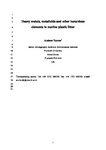Heavy metals, metalloids and other hazardous elements in marine plastic litter
| dc.contributor.author | Turner, Andrew | |
| dc.date.accessioned | 2016-08-24T14:24:31Z | |
| dc.date.available | 2016-08-24T14:24:31Z | |
| dc.date.issued | 2016-10-15 | |
| dc.identifier.issn | 0025-326X | |
| dc.identifier.issn | 1879-3363 | |
| dc.identifier.uri | http://hdl.handle.net/10026.1/5368 | |
| dc.description.abstract |
Plastics, foams and ropes collected from beaches in SW England have been analysed for As, Ba, Br, Cd, Cl, Cr, Cu, Hg, Ni, Pb, Sb, Se, Sn and Zn by field-portable-x-ray fluorescence spectrometry. High concentrations of Cl in foams that were not PVC-based were attributed to the presence of chlorinated flame retardants. Likewise, high concentrations of Br among both foams and plastics were attributed to the presence of brominated flame retardants. Regarding heavy metals and metalloids, Cd and Pb were of greatest concern from an environmental perspective. Lead was encountered in plastics, foams and ropes and up to concentrations of 17,500μgg(-1) due to its historical use in stabilisers, colourants and catalysts in the plastics industry. Detectable Cd was restricted to plastics, where its concentration often exceeded 1000μgg(-1); its occurrence is attributed to the use of both Cd-based stabilisers and colourants in a variety of products. | |
| dc.format.extent | 136-142 | |
| dc.format.medium | Print-Electronic | |
| dc.language | en | |
| dc.language.iso | en | |
| dc.publisher | Elsevier BV | |
| dc.subject | Marine plastic | |
| dc.subject | FP-XRF | |
| dc.subject | Ropes | |
| dc.subject | Foams | |
| dc.subject | Heavy metals | |
| dc.subject | Flame retardants | |
| dc.title | Heavy metals, metalloids and other hazardous elements in marine plastic litter | |
| dc.type | journal-article | |
| dc.type | Journal Article | |
| plymouth.author-url | https://www.webofscience.com/api/gateway?GWVersion=2&SrcApp=PARTNER_APP&SrcAuth=LinksAMR&KeyUT=WOS:000384854100025&DestLinkType=FullRecord&DestApp=ALL_WOS&UsrCustomerID=11bb513d99f797142bcfeffcc58ea008 | |
| plymouth.issue | 1-2 | |
| plymouth.volume | 111 | |
| plymouth.publication-status | Published | |
| plymouth.journal | Marine Pollution Bulletin | |
| dc.identifier.doi | 10.1016/j.marpolbul.2016.07.020 | |
| plymouth.organisational-group | /Plymouth | |
| plymouth.organisational-group | /Plymouth/Faculty of Science and Engineering | |
| plymouth.organisational-group | /Plymouth/Faculty of Science and Engineering/School of Geography, Earth and Environmental Sciences | |
| plymouth.organisational-group | /Plymouth/REF 2021 Researchers by UoA | |
| plymouth.organisational-group | /Plymouth/REF 2021 Researchers by UoA/UoA07 Earth Systems and Environmental Sciences | |
| plymouth.organisational-group | /Plymouth/Research Groups | |
| plymouth.organisational-group | /Plymouth/Research Groups/BEACh | |
| plymouth.organisational-group | /Plymouth/Research Groups/Marine Institute | |
| plymouth.organisational-group | /Plymouth/Users by role | |
| plymouth.organisational-group | /Plymouth/Users by role/Academics | |
| dc.publisher.place | England | |
| dcterms.dateAccepted | 2016-07-14 | |
| dc.rights.embargodate | 2017-7-22 | |
| dc.identifier.eissn | 1879-3363 | |
| dc.rights.embargoperiod | 12 months | |
| rioxxterms.versionofrecord | 10.1016/j.marpolbul.2016.07.020 | |
| rioxxterms.licenseref.uri | http://www.rioxx.net/licenses/under-embargo-all-rights-reserved | |
| rioxxterms.licenseref.startdate | 2016-10-15 | |
| rioxxterms.type | Journal Article/Review |


